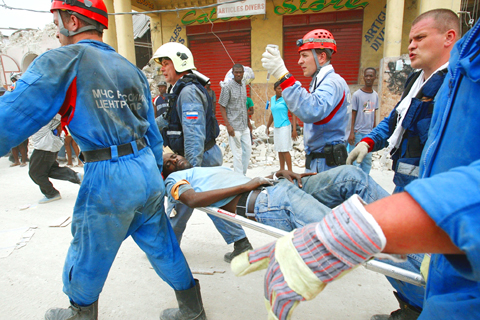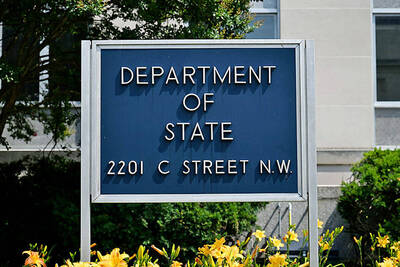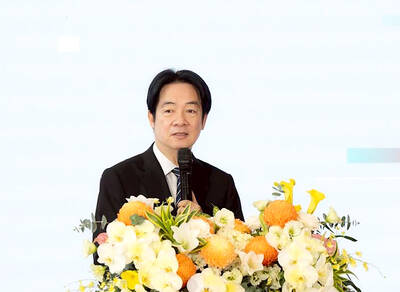A powerful new earthquake struck Haiti yesterday, shaking buildings and sending screaming people running into the streets only eight days after the country’s capital was devastated by an apocalyptic quake.
The magnitude-6.1 temblor was the largest aftershock yet to the Jan. 12 quake. It was not immediately clear if it caused additional injuries or damage to weakened buildings.
Wails of terror rose from frightened survivors as the earth shuddered at 6:03am. The US Geological Survey said the quake was centered about 56km northwest of Port-au-Prince and was 22km below the surface.

PHOTO: REUTERS
Last week’s 7.0 quake killed an estimated 200,000 people, left 250,000 injured and made 1.5 million homeless, the EU Commission said.
A massive international aid effort has been struggling with logistical problems, and many Haitians are still desperate for food and water.
Still, search-and-rescue teams have emerged from the ruins with some improbable success stories — including the rescue of a 69-year-old Roman Catholic who said she prayed constantly during her week under the rubble.
Ena Zizi had been at a church meeting at the residence of Haiti’s Roman Catholic archbishop when the Jan. 12 quake struck, trapping her in debris. She was rescued by a Mexican disaster team on Tuesday.
Zizi said after the quake, she spoke back and forth with a vicar who was also trapped. But he fell silent after a few days, and she spent the rest of the time praying and waiting.
“I talked only to my boss, God,” she said. “I didn’t need any more humans.”
Doctors who examined Zizi on Tuesday said she was dehydrated and had a dislocated hip and a broken leg.
Elsewhere in the capital, two women were pulled from a destroyed university building. And near midnight on Tuesday, a smiling and singing 26-year-old Lozama Hotteline was carried to safety from a collapsed store in the Petionville neighborhood by the French aid group Rescuers Without Borders.
Crews at the cathedral recovered the body of the archbishop, Monsignor Joseph Serge Miot, who was killed in the Jan. 12 quake.
Authorities said close to 100 people had been pulled from wrecked buildings by international search-and-rescue teams. Efforts continued, with dozens of teams hunting through Port-au-Prince’s crumbled homes and buildings for signs of life.
But the good news was overshadowed by the frustrating fact that the world still can’t get enough food and water to the hungry and thirsty.
“We need so much. Food, clothes, we need everything. I don’t know whose responsibility it is, but they need to give us something soon,” said Sophia Eltime, a 29-year-old mother of two who has been living under a sheet with seven members of her extended family.
The World Food Programme (WFP) said more than 250,000 ready-to-eat food rations had been distributed in Haiti by Tuesday, reaching only a fraction of the 3 million people thought to be in desperate need.
The WFP said it needs to deliver 100 million ready-to-eat rations in the next 30 days, but it only had 16 million meals in the pipeline.
So far, international relief efforts have been unorganized, disjointed and insufficient to satisfy the great need. Doctors Without Borders says a plane carrying urgently needed surgical equipment and drugs has been turned away five times, even though the agency received advance authorization to land.
A statement from Partners in Health, co-founded by the deputy UN envoy to Haiti, Paul Farmer, said the group’s medical director estimated 20,000 people are dying each day who could be saved by surgery.
The reasons are varied: Both national and international authorities suffered great losses in the quake, taking out many of the leaders best suited to organize a response.
A woefully inadequate infrastructure and a near-complete failure in telephone and Internet communications have also complicated efforts to reach millions of people forced from their homes, while fears of looting and violence have kept aid groups and governments from moving as quickly as they would like.

MISINFORMATION: The generated content tends to adopt China’s official stance, such as ‘Taiwan is currently governed by the Chinese central government,’ the NSB said Five China-developed artificial intelligence (AI) language models exhibit cybersecurity risks and content biases, an inspection conducted by the National Security Bureau (NSB) showed. The five AI tools are: DeepSeek, Doubao (豆包), Yiyan (文心一言), Tongyi (通義千問) and Yuanbao (騰訊元寶), the bureau said, advising people to remain vigilant to protect personal data privacy and corporate business secrets. The NSB said it, in accordance with the National Intelligence Services Act (國家情報工作法), has reviewed international cybersecurity reports and intelligence, and coordinated with the Ministry of Justice Investigation Bureau and the National Police Agency’s Criminal Investigation Bureau to conduct an inspection of China-made AI language

BOOST IN CONFIDENCE: The sale sends a clear message of support for Taiwan and dispels rumors that US President Donald Trump ‘sold out’ the nation, an expert said The US government on Thursday announced a possible sale to Taiwan of fighter jet parts, which was estimated to cost about US$330 million, in a move that an expert said “sends a clear message of support for Taiwan” amid fears that Washington might be wavering in its attitude toward Taipei. It was the first announcement of an arms sale to Taiwan since US President Donald Trump returned to the White House earlier this year. The proposed package includes non-standard components, spare and repair parts, consumables and accessories, as well repair and return support for the F-16, C-130 and Indigenous Defense Fighter aircraft,

CHECKING BOUNDARIES: China wants to disrupt solidarity among democracies and test their red lines, but it is instead pushing nations to become more united, an expert said The US Department of State on Friday expressed deep concern over a Chinese public security agency’s investigation into Legislator Puma Shen (沈伯洋) for “secession.” “China’s actions threaten free speech and erode norms that have underpinned the cross-strait ‘status quo’ for decades,” a US Department of State spokesperson said. The Chongqing Municipal Public Security Bureau late last month listed Shen as “wanted” and launched an investigation into alleged “secession-related” criminal activities, including his founding of the Kuma Academy, a civil defense organization that prepares people for an invasion by China. The spokesperson said that the US was “deeply concerned” about the bureau investigating Shen

‘TROUBLEMAKER’: Most countries believe that it is China — rather than Taiwan — that is undermining regional peace and stability with its coercive tactics, the president said China should restrain itself and refrain from being a troublemaker that sabotages peace and stability in the Indo-Pacific region, President William Lai (賴清德) said yesterday. Lai made the remarks after China Coast Guard vessels sailed into disputed waters off the Senkaku Islands — known as the Diaoyutai Islands (釣魚台) in Taiwan — following a remark Japanese Prime Minister Sanae Takaichi made regarding Taiwan. Takaichi during a parliamentary session on Nov. 7 said that a “Taiwan contingency” involving a Chinese naval blockade could qualify as a “survival-threatening situation” for Japan, and trigger Tokyo’s deployment of its military for defense. Asked about the escalating tensions